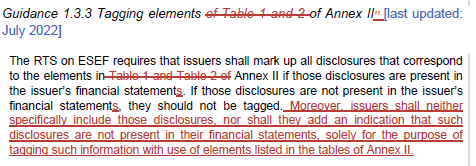This is the “technical” viewpoint. You should, however, check if your report should maybe contain information for said tag.
5. Text block tagging (Guidance 1.9)
You can find all the information in our white paper!
Or watch our text block tagging webinar on-demand and learn all about the change as well as how to implement it with our user-friendly tools: Watch the webinar now
6. Facts duplication (Guidance 2.2.4)
In prior versions duplicate tags where only mentioned for numeric tags, not for text tags. Now ESMA has clarified that also non-numeric facts that have different content for the same period are considered duplicates. If you want to tag multiple parts of the document with the same tag, you have to use the continuation mechanism of XBRL and such define a sequence of content for the same tag.
7. Tagging of dashes and empty fields (Guidance 2.2.5)
In the past there was a bit of confusion as to how fields that contain a dash “-“ or no value should be tagged in tables. ESMA clarifies that, while there is stil no requirement to tag this information, it is now recommended to tag dashes or empty cells accordingly.
If you decide to tag this information you have to be clear about the meaning of the dash.
Does it represent a 0? Then you have to apply the fixed-zero transformation.
Does it represent “nil” or “not available”? Make sure you set the AsNil property to true.
8. Technical limitations of text block tagging (Guidance 2.2.6)
XHTML documents derived from PDF documents follow a fixed document structure, while XHTML documents derived from Word document have a semantic structure. This basically means, that while Word-based XHTML documents define structures like table row, cell or paragraph properly in the source code, PDF-based XHTML documents only position the content in a way that it “looks” like for example tables.
ESMA is of the opinion that ESEF reports in the future should follow what they call “meaningful” XHTML, e.g. documents with a semantic structure. They acknowledge though, that the demand for “glossy” layout is very high and Word-based or other documents do not achieve the same level of sophistication regarding layout as PDF-based documents.
The XBRL community will take a closer look at this problem in the next years and try to tackle this problem. For now, PDF-based documents are still within the rules of the manual and no specific date for a mandated change is given.
9. Standard labels in extension taxonomies (Guidance 3.4.5)
In some jurisdictions it is a requirement by the auditors that the labels in the machine-readable part of the report resemble exactly the description in the human-readable layer. This is not a requirement from the reporting manual.
In the past this was achieved by adding new labels in the extension taxonomy that also have the label role “Standard” but a higher priority than the label in the IFRS/ESEF taxonomy. With the new reporting manual ESMA clarifies that this is no longer allowed:




